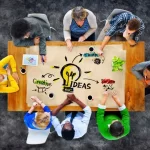Strategies for Conflict Resolution: Fostering Positive Relationships and Team Cohesion
Conflict is an inevitable part of any workplace, arising from differing opinions, goals, and personalities. However, how conflicts are managed can significantly impact team dynamics, productivity, and overall organizational success. Effective conflict resolution strategies are essential for fostering positive relationships, promoting open communication, and strengthening team cohesion. In this blog, we will explore strategies for resolving conflicts in the workplace, ultimately creating a harmonious and collaborative work environment.
Understanding Conflict Resolution:
- Early Intervention: Address conflicts as soon as they arise to prevent escalation. Timely intervention allows for more constructive and less emotionally charged discussions.
- Open Communication: Create an environment where team members feel comfortable expressing their concerns and viewpoints openly. Encourage active listening and empathetic communication.
- Collaborative Approach: Conflict resolution should be a collaborative effort, aiming for win-win solutions that consider the needs and interests of all parties involved.
- Focus on Issues, Not Individuals: Keep the focus on the problem at hand rather than attributing blame to individuals. This prevents personal attacks and allows for a more objective resolution process.
Strategies for Effective Conflict Resolution:
- Mediation: A neutral third party can facilitate discussions and guide parties toward a resolution. Mediation encourages open dialogue and helps find common ground.
- Active Listening: Encourage active listening by giving each party the opportunity to express their perspective. Repeat back their points to ensure understanding.
- Clarify Expectations: Sometimes conflicts arise from misunderstandings. Clarify expectations, roles, and responsibilities to ensure everyone is on the same page.
- Empathy and Understanding: Encourage empathy by asking team members to put themselves in each other’s shoes. Understanding different viewpoints can lead to more effective solutions.
- Brainstorm Solutions: Encourage the parties involved to brainstorm potential solutions together. This collaborative process can lead to innovative and mutually beneficial outcomes.
- Set Clear Boundaries: Establish guidelines for acceptable behavior during conflicts. Respectful communication and a focus on finding solutions should be prioritized.
- Document Agreements: Once a resolution is reached, document the agreed-upon solution, ensuring that all parties are clear on the actions to be taken.
- Follow Up: After a resolution is reached, follow up to ensure that the agreed-upon actions are being implemented and that any lingering issues are addressed.
Benefits of Effective Conflict Resolution:
- Enhanced Team Cohesion: Addressing conflicts promotes a sense of unity and mutual respect among team members, fostering stronger bonds and collaboration.
- Increased Productivity: Resolving conflicts quickly allows teams to refocus on tasks and projects, minimizing disruptions and maximizing productivity.
- Improved Communication: Conflict resolution encourages open communication, leading to better understanding and a more transparent work environment.
- Employee Well-being: Addressing conflicts reduces stress and tension, contributing to improved employee well-being and job satisfaction.
Conflict resolution is a vital skill for maintaining positive relationships and team cohesion in the workplace. By implementing strategies such as mediation, active listening, empathy, and collaboration, organizations can transform conflicts into opportunities for growth and improved communication. When conflicts are managed effectively, teams can thrive in a harmonious and supportive work environment, contributing to increased productivity, employee satisfaction, and overall organizational success.
Top of Form

































